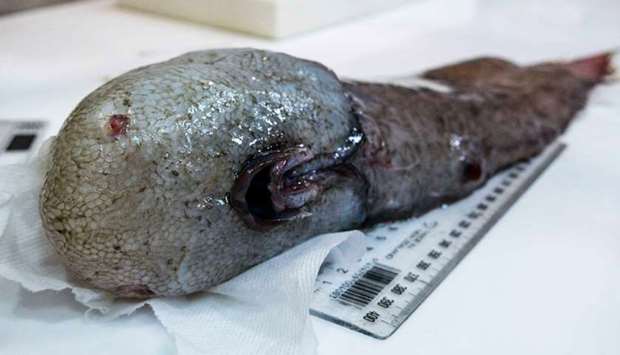Scientists have uncovered multitude of bizarre organisms, including a ‘faceless fish’ that has not been seen for more than a century, in the first two weeks of their deep-sea voyage in Australia's eastern ocean.
The international team of 40 scientists and researchers left Tasmania on May 16, heading towards Brisbane in Queensland, to uncover the mysterious life and species inhabiting the ocean abyss.
The ‘faceless fish’ was found off Jervis Bay around 4,000 metres below the surface earlier this week, Diane Bray, an Australian scientist with Museums Victoria, said on Wednesday.
‘It is really weird. It looks bizarre, blobby-shaped, a bit like octopus. It is flabby and jelly and brownish in colour,’ Bray told dpa via satellite phone from the ship off Australian coast.
‘It has no visible eyes or nose and the mouth is under the surface.’ She said it was the first time the 40-centimetre-long fish has been seen in waters off Australia's coast since one was discovered by a British research ship in the Coral Sea near Papua New Guinea in 1873.
It is among an array of mysterious and strange deep-sea creatures, which the scientists have been collecting in the depths of the ocean, including sea fleas and worms, tiny crustaceans, spiky red rock crabs, bioluminescent sea stars, and dinner plate-size blind spiders.
‘We have seen some awesome stuff. We saw a fish with photosensitive plates that sit on the top of its head, tripod fish that sit up on their fins and face into the current,’ Bray said.
The world-first research exploration is set to go on until mid-June.
Every day the scientists lower a metal sled-like device that is hooked to 8 kilometres of thick wire and with a video camera attached, to the bottom of the abyss to collect samples of animals and sediment.
‘The aim of the trip is to discover biodiversity or types of marine life that are living in the deepest parts of Australia's ocean,’ a spokesperson for Museums Victoria said.
‘The abyss is the largest and deepest habitat on the planet, covering half the world's oceans and one third of Australia's territory, but it remains the most unexplored environment on Earth,’ Tim O'Hara, chief scientist aboard the ship, said in a statement.
The deep-sea region that the scientists are researching has crushing pressures, little food and freezing temperatures. It is so dark that creatures often have no eyes and some produce their own light through bioluminescence.
O'Hara said the data gathered on this trip ‘will be crucial to understanding Australia's deep-sea habitats, their biodiversity and the ecological processes that sustain them.’ ‘This will assist in its conservation and management and help to protect it from the impacts of climate change, pollution and other human activity,’ he said.
The research team has been using a high-tech multi-beam sonar to map the structure of the seafloor, as well as cameras, nets and sleds to sample habitats between 2,500 and 4,000 metre deep.
About a third of the specimens are expected to be new to science.
Bray said they were hoping to bring some of the samples for research and exhibition.
O'Hara said there were also plenty of pollutants, including from old steam ship days when coal was tossed over board.
‘We have seen PVC pipes and we have trawled up cans of paints. In the middle of nowhere and still the sea floor has 200 years of rubbish on it,’ he said.

